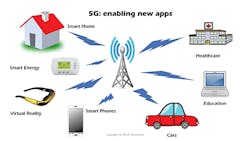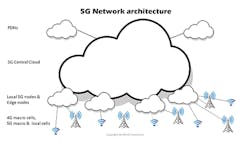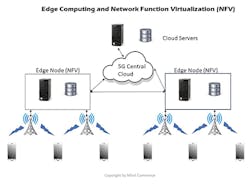A Powerful Tool for Revenue Generation —
The deployment of 5G cellular technologies will accelerate the evolution of Programmable Telecom Application Program Interfaces (APIs). These APIs will need to be enhanced to support the 5G features and services being rolled out. Telecom APIs will evolve from support of traditional telecommunications applications and services towards a larger role for network service providers in supporting intelligent solutions for enterprise as well as Internet of Things (IoT) systems, edge computing, and unified communications. (See Figure 1.)
Figure 1. API Evolution
This article summarizes what network professionals need to understand about 5G APIs and their role in supporting 5G networks and services.
Since network services are the main source of income for the Network Carriers (CSPs), CSPs seek to improve on delivering their telecommunications services and applications in response to their customer needs and requirements. Hence, we’ve seen the evolution of cellular network technologies from 2G, 3G, 4G (known also as GSM, UMTS, and LTE, respectively), to now 5G.
5G will provide consumers and enterprises with advanced applications that combine high capacity, low latency, and very high reliability, that, when combined, will revolutionize the way we interact with each other and the physical world. 5G will enable a new generation of services and create new business opportunities including smart homes, smart cities, IoT, virtual and augmented reality.
InvisiLight® Solution for Deploying Fiber
April 2, 2022Go to Market Faster. Speed up Network Deployment
April 2, 2022Episode 10: Fiber Optic Closure Specs Explained…
April 1, 2022Food for Thought from Our 2022 ICT Visionaries
April 1, 2022CSPs have just started deploying 5G to upgrade 4G broadband coverage. But long term, 5G technology will allow carrier networks to handle the vast majority of mobile telecommunications traffic, inside buildings or outside.
Therefore, Telecom APIs (developed to capitalize on existing network infrastructure and functions, offering programming interfaces to leverage those network services and technologies to enable independent development of applications) must be enhanced to support the 5G features and services being rolled out.
5G Features and Services
The 5G technology standard defines 3 services:
1. Enhanced Mobile Broadband (eMBB) is the 5G progression from 4G LTE mobile broadband services. 5G will offer faster connections, higher throughput, and more capacity than 4G LTE.
2. Ultra-Reliable Low Latency Communications (URLLC) will provide the services to support mission critical applications that requires uninterrupted and robust data exchange.
3. Massive Machine Type Communications (mMTC) provides the services to connect to a large number of low power, low cost devices, which have high scalability and increased battery lifetime, in a wide area. This is the service that will support IoT expansion.
In order to support these new services, the 5G standard defined 5G NR (New Radio) radio access technology. 5G NR will use 2 frequency ranges:
• Frequency Range 1 (FR1), including sub-6 GHz frequency bands
• Frequency Range 2 (FR2), including frequency bands in the microwave range (24–100GHz)
Using 5G NR, the theoretical 5G maximum speed is 10 gigabits per second (Gbps). (4G theoretical speed is 100 megabits per second (Mbps.) In practice, 5G will bring higher speeds for users, but those speeds will vary depending on how CSPs design their networks and the number of users using that network. 5G is designed to support up to a million devices per square kilometer, while 4G supports up to 100,000 devices per square kilometer.
In 5G, the target latency through the air is 1-4 milliseconds. Current 5G equipment shipping in 2019 has tested air latency of 8-12 milliseconds. The air latency must be added to the network latency to reach the targeted server to define the overall latency.
With 5G providing the services to support IoT, there will be an explosion of connected devices and systems on 5G networks. These IoT devices will generate large amounts of data. While 5G promises of faster throughput speeds and lower network latencies, the expectation is that much of this IoT-generated data will need to be processed in real time. How is 5G technologies expecting to lower network latencies?
The key to lowering network latency will be the 5G architecture. (See Figure 2.)
Figure 2.
One of the key components in allowing 5G to address the data throughput concerns is Edge Computing. Edge computing is a distributed computing paradigm which brings computation and data storage closer to the source (i.e., client). This allows for faster processing of data, reducing latency, saving bandwidth, and improving customer experiences.
Secondly, to support the defined 5G services, throughput, and latencies, the 5G radio access network (RAN) will support a mixture of macro cell towers, small cells, inbuilding and home radio transmission systems to connect mobile users to the 5G core network. Macro cells will use the lower FR1 frequencies while the smaller cells will use the FR2 frequencies.
Third, 5G has redesigned the 4G core network to allow better integration with the Internet and cloud-based services. This includes distributed servers across the network to reduce network latency. 5G will use network function virtualization (NFV) and network slicing features, in the core network, to provide support for the different applications and services that are planned to 5G services.
Network Slicing is a network architecture that supports the multiplexing of virtual and independent logical networks on the same physical network infrastructure. Each network slice is an isolated end-to-end network engineered to fulfil the requirements requested by a particular application.
NFV uses IT technologies to virtualize classes of network node functions, and uses them to create building blocks that may connect, or chain together, communication services. As an example, network firewall or encryption functions can now run on a virtual machine, instead of running on dedicated hardware at business premises. NFV provides the speed efficiency and agility to support new business applications, and is an important technology for a 5G core network.
5G Launches
In 2019, CSPs started deployment of initial 5G services throughout the world. Currently, network carriers are deploying 5G to upgrade 4G networks providing eMMB services only. URLLC and mMTC services are expected to start being deployed in 2021. Widespread 5G availability is expected by 2025. Short term, 5G networks will have 4G LTE support, and will use existing 4G spectrum, which will provide slower speeds but broader coverage.
In the US, the 4 major US carriers offer some form of 5G wireless services. But, 5G service is limited and available in only a few cities (i.e., there isn’t much coverage. Much of the 5G service is limited to 5G hotspots). By early 2020, AT&T, Verizon, and T-Mobile, all intend to launch 5G networks that use existing 4G spectrum.
The expectation is that 5G applications will start becoming available in 2021 or 2022. The first 5G applications are expected to be fixed wireless access for homes and can use eMMB services.
Edge Computing API Requirements
As mentioned above, edge computing is a distributed computing paradigm which brings computation and data storage closer to the source (i.e., client). (See Figure 3). It will be a critical component used in 5G for faster processing of data, reducing latency, and saving bandwidth.
Figure 3.
Edge Computing Standards defines various API interfaces including application enablement, service APIs, and the User Equipment (UE) application APIs. These APIs will enable underlying 5G network information and capabilities to applications, allowing applications to gain real-time awareness of their networking environment.
3GPP 5G API Requirements
The 3rd Generation Partnership Project (3GPP) defined the new 5G API interface platform to address all of the new 5G service scenarios. They define the framework that support developers, and make it easier to create new 5G services. These requirements include:
• Support 5G service-based architecture and expose their network functions
• Guarantee 5G core stability with rate limitations
• Exposure of RESTful APIs
• Single API gateway function for all core
• APIs Monitoring and provisioning functions
• Policy and charging functions
• Exposure of core network internal capabilities for analytics
But 3GPP API requirements caused a series of issues. The existing multivendor network components must be accessed through a single API gateway. Existing APIs must be integrated with the 3GPP API gateway. Plus, API providers must provide support to their existing developer and enterprise customers in migrating to the new 5G APIs.
To meet the 3GPP requirements, CSPs must provide and require new products and business models that support their single API gateway.
• Providing developer support programs.
• Providing new 5G APIs, managing their traffic, and guaranteeing their security, data privacy and interoperability.
• Properly documenting all functions and SDKs.
• Security and integrity of the back-end system through authentication and rate limiting.
• Supporting interworking between different systems and different APIs.
Summary
With 5G technology, CSPs have to re-evaluate the purpose of their network services. 5G has redefined the network from just being connectivity infrastructure, to also being a programmable platform used to create new applications based on collaboration. 5G enables the CSPs to use their 5G network programming abilities to maximize innovation, minimize time to market, and create great new services for consumers and enterprises, while increasing revenue.
The role of the Telecom API market is evolving to support 5G. 5G is changing the network to a service-based architecture. 5G requirements for API will provide functions needed to support the increasingly more consumer-oriented communications, applications, commerce, and digital content that will be developed for 5G networks. This evolution extends beyond traditional API support for traditional ICT apps and services towards a larger role for network service providers in intelligent solutions for enterprise as well as Internet of Things (IoT) systems and networks.
Like this Article?
Subscribe to ISE magazine and start receiving your FREE monthly copy today!
Providers (including CSPs) of the Telecom API platforms will need a 5G API support strategy, which includes their API platform support of 3GPP 5G standards.
For the forthcoming 5G API era, CSPs need to view their programmable network as an API platform, and use it as a way of partnering in and supporting the creation of applications, contributing to building a new 5G telco API based ecosystem. If the API exposure platform is well designed and allows openness for other APIs, then developers are one step closer to implementing their business logic in new services.
About the Author








